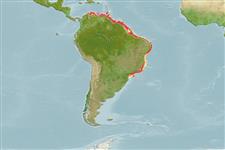>
Eupercaria/misc (Various families in series Eupercaria) >
Sciaenidae (Drums or croakers)
Etymology: Cynoscion: Greek, kyon = dog + Greek, odous = teeth + Greek, skion, skiaina = barbel, red mullet (Ref. 45335).
More on author: Cuvier.
Environment: milieu / climate zone / depth range / distribution range
Ecologia
marinhas; estuarina demersal; intervalo de profundidade 10 - 50 m (Ref. 9626), usually ? - 25 m (Ref. 9626). Tropical; 14°N - 27°S, 83°W - 34°W
Western Atlantic: Panama to Santos, Brazil. Also reported in Nicaragua (Ref. 13613).
Tamanho / Peso / Idade
Maturity: Lm ? range ? - ? cm
Max length : 90.8 cm TL macho/indeterminado; (Ref. 9626); common length : 35.0 cm TL macho/indeterminado; (Ref. 3702); peso máx. publicado: 2.0 kg (Ref. 5217)
Espinhos dorsais (total) : 11; Raios dorsais (total) : 20 - 24; Espinhos anais: 2; Raios anais : 8 - 10. Silvery bluish on back, often with greenish reflections. Whitish on belly. Upper sides sometimes with inconspicuous minute dark dots. Soft portion of dorsal fin and caudal fin edged with black, pelvic and anal fins yellowish. Inside of opercle dark, visible externally. Mouth large, pointed, lower jaw projecting. Upper jaw with a pair of large canine-teeth at tip. Chin without barbel or obvious pores. Snout with 2 marginal pores. Gas bladder with a pair of curved, horn-like anterior appendages. Scales small, all cycloid (smooth). Soft dorsal-fin base with 1 or 2 rows of scales along its base (Ref 51721).
Found over mud and sand bottoms in river estuaries. Occurs up to 50 m but usually less than 25 m (Ref. 9626). Marketed fresh and salted.
Ciclo de vida ou comportamento de acasalamento
Maturities | Reprodução | Spawnings | Egg(s) | Fecundities | Larvas
Cervigón, F., 1993. Los peces marinos de Venezuela. Volume 2. Fundación Científica Los Roques, Caracas,Venezuela. 497 p. (Ref. 9626)
Status na Lista Vermelha da UICN (Ref. 130435)
Ameaça para os humanos
Harmless
Uso pelos humanos
Pescarias: espécies comerciais; peixe esportivo: sim
Ferramentas
Relatórios especiais
Baixar XML
Fontes da internet
Estimates based on models
Preferred temperature (Ref.
123201): 24.8 - 27.9, mean 27.3 °C (based on 60 cells).
Índice de diversidade filogenética (Ref.
82804): PD
50 = 0.5000 [Uniqueness, from 0.5 = low to 2.0 = high].
Bayesian length-weight: a=0.00794 (0.00509 - 0.01238), b=3.07 (2.95 - 3.19), in cm total length, based on LWR estimates for this species & Genus-body shape (Ref.
93245).
Nível Trófico (Ref.
69278): 3.1 ±0.40 se; based on food items.
Generation time: 3.1 ( na - na) years. Estimated as median ln(3)/K based on 1
growth studies.
Resiliência (Ref.
120179): médio(a), tempo mínimo de duplicação da população 1,4 - 4,4 anos (Preliminary K or Fecundity.).
Fishing Vulnerability (Ref.
59153): Moderate vulnerability (37 of 100).
Nutrients (Ref.
124155): Calcium = 93.2 [57.6, 183.3] mg/100g; Iron = 0.965 [0.503, 1.639] mg/100g; Protein = 18.3 [16.7, 20.0] %; Omega3 = 0.195 [0.107, 0.317] g/100g; Selenium = 64.8 [36.2, 121.6] μg/100g; VitaminA = 10.7 [4.4, 26.2] μg/100g; Zinc = 1.17 [0.86, 1.67] mg/100g (wet weight); based on
nutrient studies.
